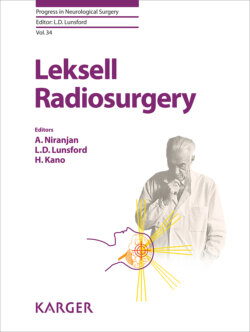Читать книгу Leksell Radiosurgery - Группа авторов - Страница 15
На сайте Литреса книга снята с продажи.
The Turning Point
Оглавление1987 would prove a turning point. Dade Lunsford had spent time with us at the Karolinska Hospital in 1980 and 1981. As he returned to Pittsburgh he decided to take the biggest professional and personal risk of all who preceded him as, in 1982, he began the process of getting a GK to UPMC. The process would take 5 years and the details of the trials and tribulations Lunsford ran into are detailed in the following chapter of this volume [pp. 9–18].
Prior to the establishment of the center in Pittsburgh, the predominant indication for GKS was AVMs. There was not much in the literature regarding benign tumors such as vestibular schwannomas. With the installation in Pittsburgh and the subsequent proliferation of GK centers in the USA and elsewhere, the published evidence in favor of SRS for vestibular schwannomas rapidly increased. This started what I call the second world war – that with the neurotologists. This lasted from approximately 1989 to the early 2000s, by which time the most hardened anti-SRS otologists had taken the GK course and started using the GK themselves.
As already mentioned, malignant disease was off-limits in Stockholm and also in Pittsburgh this was not a consideration in the early years. In the first years of the 1990s the treatment of metastases with GK began, but initially only for solitary tumors, traditionally the domain of neurosurgery and not a problem. These lesions often melted away after the procedure and it was not long before neurosurgeons started treating multiple metastases with the GK. This started the third world war, this time with the radiation oncologists who felt that their turf was being encroached upon by the neurosurgeons. This became the fiercest battle in the history of SRS politics and would last well over 2 decades.
Radiation oncologists are trained to fractionate radiation delivery and the mere thought of single-session high-dose radiation surgery was, and to some still is, anathema. The mantra was “single-session high-dose radiation is dangerous!”
I recall when Jerzy Einhorn, the late chairman of radiation oncology at the Karolinska Hospital, had his retirement party in the late 1980s. The GK had been installed in the basement of his own building, Radiumhemmet, for 15 years, but he had never seen it. As the party came to an end I said – Jerzy you cannot go home without first coming with me to see the GK with your own eyes. His terse reply was – no, no Danny, I’m not interested, all radiation is radiation therapy!
Over time the evidence in favor of SRS for multiple metastases has accumulated [13]. At the same time the evidence against whole-brain radiation therapy (WBRT) has mounted as well [14]. Its deleterious effects on neurocognition are now recognized and as I write these words we are seeing a growing number of avant garde radiation oncologists adopting SRS and the GK. Also, in the last few years guidelines from various organizations for the treatment of cerebral metastases have changed in the USA and elsewhere. In 2014, ASTRO suggested that WBRT should not be routinely added to SRS and in the same year the NCCN modified their guidelines as well. It is encouraging to see that clinical practice changes with the peer-reviewed published evidence and I think that we will soon see a truce in this third world war of SRS.
